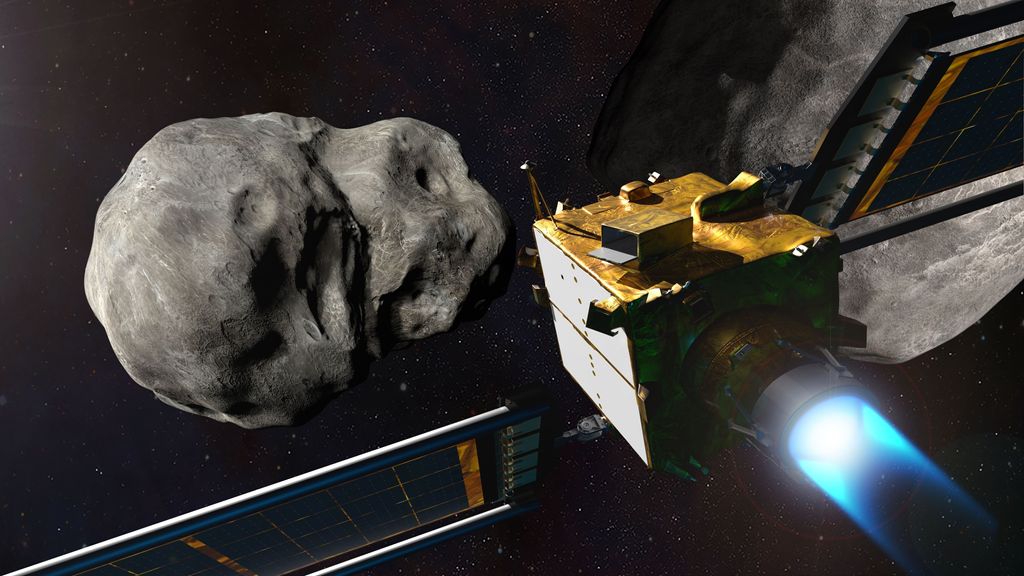NASA/Johns Hopkins APL
NOS . News•
At 1:14 am tonight, a high-speed US space probe will collide with a space rock. And that is exactly the point. NASA is studying whether such a maneuver could alter the course of an asteroid threatening to strike Earth.
Just to reassure you: there is no danger, this is a test. The target is Demorphos, an asteroid 160 meters wide that orbits its older sister Didymos at an altitude of about 750 metres. Together they orbit the sun in 770 days. They are getting closer to Earth this year within 10.6 million km. Space rocks are not on a collision course with Earth, nor can a collision accidentally push them into our path.
It is the first time that it has been tested whether Earth can be defended in this way. DART, which stands for Double Asteroid Redirection Test, was launched in November 2021.
Here’s how the trip to Dimorphos went:
The threat from space doesn’t seem too great at the moment. Of all the asteroids orbiting the sun close to Earth, not one larger than 140 meters will strike in the next century.
But NASA also estimates that we don’t know half of all asteroids yet. In addition, even the smallest rocks can cause massive destruction. And in the long run, it’s almost inevitable that another dangerous rock will one day collide. This is why it is wise to test which defense works.
Scientists have already devised different defense methods. A lot of people will watch the movie disaster Think, where a rock is detonated with an atomic bomb.
DART takes the step from action movie to reality, albeit less exciting: the asteroid is getting a “boost”. By changing course so much of the time, the boulder misses the ground at a great distance.
Extremely high speed
However, hitting the target is not so easy. “You’re trying to hit something small that’s moving with something that’s also moving at high speed,” says Michel van Pelt. This ESA engineer will bite the nail Watch the live broadcast tonight.
DART is so far away that it takes 1.5 minutes for instructions to arrive. Since the probe flies at more than 24,000 kilometers per hour, this means that DART is already more than 500 kilometers away. And although the target is so small that the DART camera can only distinguish the rocks from the larger Didymus, it rotates an hour before impact.
NASA provided a schematic representation of the mission’s purpose:

NASA/Johns Hopkins APL
For the past four hours, DART has been flying entirely on autopilot. A special tool uses information from camera images and the location of the stars in the sky, among other things.
“Miss the end of the mission”
“If they miss the asteroid, the mission is over immediately. Then you fail completely. You can’t turn around,” says Van Pelt. We will likely know soon if it worked. DART has a built-in camera that takes pictures up to 5 seconds before impact. The antennas on the ground remain connected to the end.
Three minutes after the collision, a small Italian satellite circled to take care of the damage. LICIAcube was disconnected last September 11th. Telescopes from Earth monitor changes in Demorphos’ orbit.
It is unclear what the impact of the collision will be. This depends on the composition of the asteroid. You may get a strong bang. Then DART creates a deep hole and a lot of material is dumped into the space.
But asteroids are mostly not huge but very porous. Then DART disappears deep into the space rock without much effect. “If we knew what was going to happen, we wouldn’t have to do it,” says Van Pelt. It is precisely the knowledge that is gained that should help improve existing computer models.
Follow-up mission takes damage
With the HERA mission, the European Space Agency will investigate collisions on a larger scale in the coming years. This probe will travel to Didymos and Demorphos in 2024 and will take a more detailed look at what happened and measure how the orbit has changed.
In addition, if a deep crater was created, HERA could even see the interior of the asteroid – about which little is known. This will require some patience: HERA is expected to reach its destination in December 2026.







